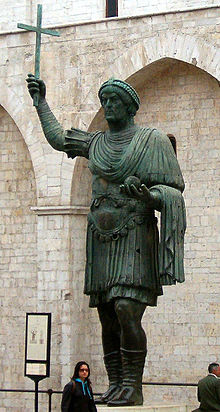Colossus of Barletta
The Colossus of Barletta is a bronze statue made using the wax casting process , which was probably made in the second half of the 5th century and is now in the port city of Barletta in Apulia . The statue, which is now 5.11 m high and whose ancient structure reaches a height of 3.55 m up to the diadem, was first mentioned in 1309 as the royal property of Charles II of Anjou and was almost completely preserved in the port of Barletta. In 1491, missing parts on the arms and legs were added, and parts of the robe and neck were mended. The skullcap is missing.
It is not clear who the statue represents; it probably represents one of the late Roman emperors, whether Markian (450–457), Leo I (457–474) or another is unclear.
origin
The bronze statue may originally have been part of a columned monument that stood in Constantinople . There are different theses in science about how the statue got to Bari. It is conceivable that the statue was sent to Italy as early as late antiquity , because it was customary for 395 statues of the eastern emperors recognized in the west to be erected there even after the so-called division of the empire . It is known that Frederick II had a bronze statue of the emperor from Ravenna , the former royal seat of western Rome , moved to southern Italy, but never made it there. Possibly it was the Colossus of Barletta.
According to another thesis, the statue was brought back by the Venetians after the sack of Constantinople in 1204 and was lost in a shipwreck off the Salentine coast.
description
In the opinion of most researchers, it is certain that it is a portrait of a late antique emperor, Eastern Estrom . The formerly almost five meter high colossus is clad in two tunics , armor, sash and paludamentum , the head is crowned with a diadem in the straight and half-long hair, only trimmed at the edge. Overall, the statue is designed to work from a distance, since the individual forms are not very differentiated.
The style elements clearly indicate an Eastern Roman origin. The statue was previously thought to be an image of the emperor Herakleios (610–641), but this assumption has long been disproved. The identification as Valentinian I (364–375), which was represented in older research, is also mostly rejected today, as is that as Honorius . The exact date is still disputed, but today it is very likely that it originated in the second half of the 5th century. The rather untypical (hinted) beardness for depictions of emperors according to Diocletian supports the interpretation of the statue as a portrait of the Eastern Roman emperor Leo I (457–474), who is shown bearded on some coins (Johnson 1925); but identification as emperor Markian (450–457) is also possible (in contrast to Leo, however, he did not have a beard). Both emperors repeatedly intervened in the fortunes of West Rome .
literature
- Herbert Koch : bronze statue in Barletta. In: Ancient monuments. Volume 3, Issue 2, 1912–1913, pp. 20–27, plates 20–21 ( digitized version ; fundamental to the post-ancient sources; interpreted as Valentinian I. ).
- Franklin Johnson: The Colossus of Barletta. In: American Journal of Archeology . Volume 29, 1925, pp. 20-25.
- Richard Delbrueck : Late antique imperial portraits. From Constantinus Magnus to the end of the western empire (= studies of late antique art history . Volume 8). De Gruyter, Berlin / Leipzig 1933 (unchanged photomechanical reprint 1978), ISBN 3-11-005700-X , pp. 219–226, plates 116–120 (interpreted as Markian).
- Émilienne Demougeot: Le Colosse de Barletta. In: Mélanges de l'école française de Rome. Volume 94, 1982, pp. 951-978 ( online ; interpretation as Honorius ).
- Martina Jordan-Ruwe: The column monument. On the history of the elevated installation of antique portrait statues (= Asia Minor Studies. Volume 19). Habelt, Bonn 1995, p. 167.
- Karin Hornig: The Colossus of Barletta. Odyssey of a Constantinian statue. In: Skyllis. Volume 8, Issue 1/2, 2007/2008, pp. 100-123.
- Gereon Siebigs: Emperor Leo I. The Eastern Roman Empire in the first three years of his reign (457–460 AD). De Gruyter, Berlin / New York 2010, ISBN 978-3-11-022584-6 , pp. 741-746 (interpreted as Leo I.).
- Bente Killerich: The Barletta Colossus Revisited: The Methodological Challenges of an Enigmatic Statue. In: Acta ad Archaeologiam et Artium Historiam Pertinentia. Volume 28, 2015, pp. 55–72 ( PDF; 2.4 MB, English ).
Web links
Individual evidence
- ^ So Bernard Andreae : Barletta. In: Lexicon of the Old World . Volume 1. Augsburg 1994, Col. 437.
- ↑ Gereon Siebigs: Emperor Leo I. The Eastern Roman Empire in the first three years of his reign (457–460 AD). de Gruyter, Berlin / New York 2010, pp. 741–746.
- ↑ Alexander Demandt : The late antiquity. Roman history from Diocletian to Justinian. A.D. 284-565 (1989), p. 218.
